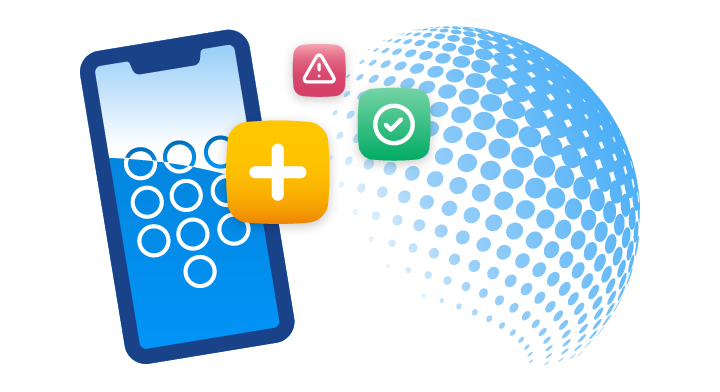Contact Center Phone Numbers:
Best Practices to Optimize Your Global Reach
In today’s highly interconnected world, businesses are facing challenges aligning who they need to contact with the best way to reach them. And part of the problem is a seemingly very simple piece of the puzzle – your business phone numbers.
When juggling multiple providers to acquire coverage and number types around the world, creating an extensive footprint of phone numbers that optimizes voice engagement outcomes with customers can be hard to execute.
Not only does this impede market effectiveness, but if you’re not procuring phone numbers from a high-quality voice partner, it may also lead to frustrating Quality of Service (QoS) issues and expensive international call rates.
Leading enterprises are not only avoiding these common pitfalls, but rather they are employing multiple best practices to turn their virtual numbers into a strategic advantage. In this guide, you'll learn about the right approaches to properly develop your contact center’s phone numbers and optimize your global reach.
Best Practice #1
Identify phone number types that position you to most successfully connect with your customers.
There are multiple options to choose from when deciding what types of phone numbers to leverage, each with its unique characteristics and benefits. Companies also have different go-to-market scenarios they must deploy their phone numbers for.
While there are many potential combinations, there are a few key drivers that can help effectively match phone number types to each scenario. To do so, evaluate the following:
Inbound Versus Outbound Calling
Inbound
Facilitating an inbound call strategy commands phone numbers with unique call features and one-way dialing capability for customers to reach you. These number types include international toll-free service (ITFS), local direct inward dialing (DID), non-geographic (or national), and universal international freephone numbers (UIFN).
ITFS and UIFN numbers allow customers to contact your business at no cost to them. Local DIDs and non-geographic numbers, on the other hand, suggest to the caller they will speak with a representative nearby– even if they’re technically not in the area.
Outbound
An outbound call strategy can benefit from local presence dialing phone numbers. These numbers guarantee Local Caller ID in the cities you’re calling into, which increases your answer rates. Because of its two-way voice technology, customers can easily call you back on the same phone number.
Additionally, when a customer is expecting your call, matching call IDs for inbound and outbound number types will instill a sense of familiarity in your customers.
Brand Strategy
There are phone numbers to represent your business as a local in the community, with national recognition or an international presence.
Working with your business stakeholders to define how you want to position your company across regions, target customers and market initiatives can help crystalize your number decision.
Customer Types
Different customer segments may respond to and engage differently to the types of phone numbers you have, and as such, should be incorporated into your number strategy.
For inbound calls,
think about the typical customer who is making the call.
How sensitive are your customers to call charges? What number types are they most familiar with?
For outbound calls,
many countries have standard phone number structures that are easily recognizable and increase engagement.
Customers throughout different countries may respond differently to those numbers.
Desired Outcomes
Ultimately, these factors must be weighed against your desired outcomes.
Key questions to ask yourself:
- Are high answer rates mission-critical?
- Is ease of calling for customers important for your local markets?
- How do you want to position yourself against competitors?
These and other questions should be considered before you develop a business case.
Efficient communications are at the heart
of growing your contact center operations.
Best Practice #2
Weigh the benefits of deploying different types of numbers against their associated costs.
Different number types have different benefits and costs that must be understood. Generally speaking, vanity and local presence dialing phone numbers carry a small premium relative to other options. Depending on how much value your business places on your target benefits, the cost may be a factor in selecting one phone number type over another.
Use your international cloud voice provider as a resource to help you 1) identify and 2) understand the costs of your voice service relative to that of your historical and projected call traffic trends.
Work alongside other areas of your business to develop a cost-benefit analysis of your desired numbers. The benefits could include:
- Increased sales from improved answer rates
- Improved customer satisfaction
- Reduced agent time spent trying to reach customers
Keep in mind these metrics may vary by region, so it’s recommended to detail out the costs and benefits for your markets. Some enterprises may choose to focus this exercise on the largest or most important markets instead of accounting for every scenario.
Global voice providers often have cost-saving measures in place to help businesses track their spending. Consolidated telecommunications can also lower your Total Cost of Ownership (TCO) for phone numbers that are beneficial to your business goals.
Best Practice #3
Identify a voice provider you can partner with and scale over time.
If you’re operating in a multinational setting - or plan to be - make sure your cloud voice service provider can support you in the markets you currently need, can get you the numbers you need in the future, and is fully committed to compliance in participating markets you care about.
Many companies make the mistake of not planning ahead when it comes to voice procurement. This can lead to not being able to secure numbers needed to enter markets in a timely manner, working with a fragmented set of providers, or paying more than is necessary due to lack of time for proper due diligence.
Follow these four steps to select the right long-term voice partner(s):
Start by collaborating among departments
Collaborate in your organization to determine the prospective cities and countries where you’ll need voice service, including the number types that will be most relevant. Although plans can always change, it can help to have a line of sight into future needs.
Partner with a reliable provider
Partner with a cloud voice provider that has a global phone number inventory, consistent call quality across geographies, number management features, and industry knowledge to scale your global reach on your terms.
Additionally, another benefit of building a strong relationship with a cloud voice partner is that when a need for new numbers arises, you’re not scrambling to source them. Your voice partner already has them.
Understand and determine your roadmap
Provisioning and porting processes tend to be quick, but numbers in large batches and more hard-to-find locations can take time. It’s the nature of the industry, and the process of working with in-country voice providers takes time to do it right.
When acquiring voice services, make sure you’ve discussed program lead times with your provider so that your implementation roadmap remains on schedule.
Build your number inventory efficiently
These fortified relationships can get the numbers you need turned on quickly, whether it’s through available inventory or your cloud voice partner sourcing from their downstream provider network.
This approach will also reduce the management burden of your phone numbers through more streamlined contracts.
Best Practice #4
Understand how your voice provider obtained its inventory.
While there are still markets that are hard to come by because of strict regulations and political climates, most countries now back open (whether post-COVID or easing back restrictions) are seeing increasing demand for phone numbers.
Ask your providers how they’re obtaining these historically tricky markets. Make sure that the phone numbers you’re getting are reliable, admittedly sourced and confirm that they are using clean numbers to abide by robocall mitigation laws.
Global voice providers like AVOXI have long-term relationships with in-country partners to deliver the types of numbers and markets customers need most.

Best Practice #5
Choose providers that are committed to and understand regulations within your markets.
Supporting your global presence means staying up-to-date with regulatory trends so you can determine your provider’s commitment to your key countries and markets. Because without regulatory compliance, you could be at risk of losing your phone numbers and causing significant business disruption.
A high-quality cloud voice provider will follow all of the communications legislation standards of the countries you’re expanding to. This entails knowing the appropriate documentation needed to provision numbers and the use cases that are permissible for different number types.
Is your voice provider tracking regulations?
Cloud voice providers also need to have the appropriate compliance and certifications to be able to participate and source phone numbers in those countries and markets for your business.
Some may choose not to make the requisite investments, which means you won’t have voice support in those locations. It’s worth asking your current and prospective providers what trends they are seeing in various markets and how they are responding.
Best Practice #6
Check that your numbers are performing as expected across key metrics.
When you add more markets to your voice system, tracking phone number performance can become challenging.
Key metrics
If you’re working among several systems, consolidated inventory plus holistic view analytics can provide better visibility into key metrics like answer rates, total calls, and max duration across your numbers. That will help you determine if you are achieving the cost and benefit objectives within your business case mentioned above.
Automated number testing
Additionally, as your voice footprint grows, ensure that all of your phone numbers are in service. Automated number testing tools keep you informed of outages, so you can resolve those out-of-service numbers before your customers find out.
TAKE ACTION
Achieve Your Global Voice Reach Anywhere
Expanding your business reach and attracting new audiences represent meaningful growth opportunities. To ensure success, identifying a global cloud voice partner that has the expertise, experience, and ecosystem to deploy the phone numbers you need is foundational.
AVOXI, a leading global voice service provider with extensive experience in telecommunications, has a breadth and depth of phone number inventory across 150+ countries, plus an intuitive one-stop-shop platform designed to simplify how you manage your voice channel. AVOXI makes cloud voice easy, so you can reach your customers anytime, anywhere.
Related Articles
International Phone Numbers for Better Global Communications
Enhancing your global communications? Learn how the right international phone numbers can help you scale your portfolio.
Continue Reading >Which Numbers Can I Make Outbound Calls From?
Not all number types have the capabilities to make outbound calls. Learn the ones that do and more here.
Continue Reading >UIFN vs ITFS: Which Toll-Free Number is Right for Your Business?
Expanding your business’s global presence? Consider adding a UIFN or ITFS number so your customers can call in for free.
Continue Reading >


